Introduction
The art of clowning has existed for thousands of years. A pygmy clown performed as a jester in the court of Pharaoh Dadkeri-Assi during Egypt's Fifth Dynasty about 2500 B.C. Court jesters have performed in China since 1818 B.C. Throughout history most cultures have had clowns.
When Cortez conquered the Aztec Nation in 1520 A.D. he discovered Montezuma's court included jesters similar to those in Europe. Aztec fools, dwarf clowns, and hunchbacked buffoons were among the treasures Cortez took back to Pope Clement VII. Most Native American tribes had some type of clown character. These clowns played an important role in the social and religious life of the tribe, and in some cases were believed to be able to cure certain diseases.
Court Jesters
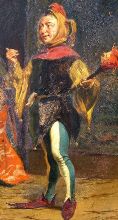
Clowns who performed as court jesters were given great freedom of speech. Often they were the only one to speak out against the ruler's ideas, and through their humor were able to affect policy. In about 300 BC Chinese emperor Shih Huang-Ti oversaw the building of the Great Wall of China. Thousands of laborers were killed during its construction. He planned to have the wall painted which would have resulted in thousands more dying. His jester, Yu Sze, was the only one who dared criticize his plan. Yu Sze jokingly convinced him to abandon his plan. Yu Sze is remembered today as a Chinese national hero.
One of the most famous of the European court jesters was Nasir Ed Din. One day the king glimpsed himself and a mirror, and saddened at how old he looked, started crying. The other members of the court decided they better cry as well. When the king stopped crying, everyone else stopped crying as well, except Nasir Ed Din. When the king asked Nasir why he was still crying, he replied, "Sire, you looked at yourself in the mirror but for a moment and you cried. I have to look at you all the time."
Commedia del Arte

The Commedia del Arte began in Italy in the sixteenth century and soon dominated European theater. It was a highly improvised theater based upon stock characters and scenarios. It contained many comic characters divided into masters and servants. There were three types of comic servants: the First Zany, the Second Zany, and the Fantesca. The First Zany was a male servant who was a clever rogue often plotting against the masters. The Second Zany was a stupid male servant that was caught up in the First Zany's schemes and often the victim of his pranks. The Fantesca was a female servant, played by an actress, who was a feminine version of one of the Zany characters and would participate in the schemes and provide a romantic story among the servants.
The history of clowning is a history of creativity, evolution, and change. Harlequin started off as a Second Zany, the victim of Brighella. Performers portraying Harlequin gradually made him a smarter character until he eventually usurped Brighella's position. In English Pantomime, a style of theater based on the Commedia del Arte, John Rich completed the evolution of Harlequin elevating it to starring position. New characters evolved to assume the position of Harlequin's stupid victims. One of these was the whiteface clown.
William Kemp and Robert Armin
Shakespeare's Clowns
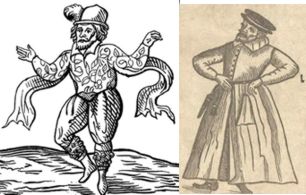
During the reign of Queen Elizabeth, clowning in England was basically a theatrical art form. Shakespeare was the playwright for the Lord Chandler's Men acting troupe. Of the 26 principal actors in the Lord Chandler's Men listed in the First Folio of Shakespeare's plays, two, William Kemp and Richard Armin, were clowns. William Kemp was the first clown to appear with the troupe. He was such an important star that he was a part owner in both the troupe and the Globe Theater. He specialized in playing stupid country bumpkin type characters (a style that would later become known as the Auguste).
Robert Armin (c.1568 - 1615) joined the company when Kemp left. He specialized in playing court jester style fools. He wrote a book on famous court jesters, one of the first histories of clowning to be published.
The style of Shakespeare's plays changed when Armin replaced Kemp so it is known that he tailored them to the style and abilities of his clowns. Scholars believe that part of the existing scripts were actually ad libs by the clowns that were written down after they proved popular.
According to tradition, Hamlet's order that clowns speak only what had been written down for them was in reality Shakespeare's criticism of Kemp's ad libbing.
The First Circus Clown
Philip Astley created what is considered the first circus in England in 1768. He also created the first circus clown act called Billy Buttons, or the Tailor's Ride To Brentford.
His act was based on a popular tale of a tailor, an inept equestrian, trying to ride a horse to Brentford to vote in an election. Astley
portrayed the tailor attempting to ride the horse. First he had great difficulty mounting
the horse correctly, and then when he finally succeeded the horse started off so fast that he fell off. As the circus grew and Astley hired other clowns, he required them to learn Billy Buttons. It soon became a traditional part of every circus
for the next century. Variations of the routine, occasionally with somebody coming out of the audience to attempt to ride
a horse are still being performed in modern circuses.
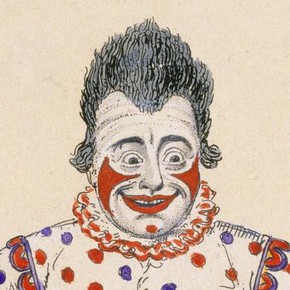
Joseph Grimaldi
The Father of Modern Clowning
Joseph Grimaldi (1778 - 1837) was exclusively a theatrical clown. He is considered the Father of Modern Clowning because he is the entertainer who elevated the Whiteface clown to a starring role replacing Harlequin.
Grimaldi grew up in the theater, and excelled at designing elaborate trick special effects. The type of production he starred in resembled a live action Roadrunner Cartoon with chase scenes and comic violence with extreme but temporary results.
Grimaldi was known for his comic songs, in particular an audience participation song called Hot Codlins. Besides appearing as a whiteface clown, Grimaldi also performed in blackface portraying "noble savages" such as Friday in a comic production of Robinson Crusoe.
The First Female Circus Clown
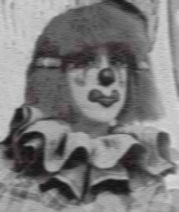
Amelia Butler
The first female American circus clown was Amelia Butler who portrayed a recognizably feminine clown in 1858 while touring with a show called Nixon's Great American Circus and Kemp's Mammoth English Circus.
Dan Rice
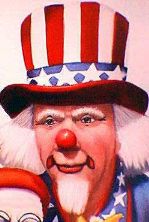
"Yankee" Dan Rice (1823-1901) was a clown of the Civil War era. Like Will Rogers and Bob Hope he commented humorously on current events. A composer, he created many popular topical songs. He campaigned for Zachary Taylor for President. One of the things he would do was invite Taylor to ride on the circus bandwagon in the circus parades. Local politicians would clamor to ride as well hoping his popularity would benefit them. People would comment, "Look who's on Taylor's bandwagon," inspiring the phrase "jump on the bandwagon."
Rice had a goatee and wore a patriotic costume he referred to as his flag suit. Political cartoonist
Thomas Nast based his drawings of Uncle Sam on Rice and his costume.
Dan Rice was an accomplished animal trainer. He specialized in pigs and mules, which he trained and sold to other clowns. He also presented an act with a trained rhinoceros and is the only person in circus history to present a tightrope walking elephant.
Rice was the highest paid person in America some years, earning more then his close personal friend Abraham Lincoln.
He was also a philanthropist who gave generously to many charities and
he erected the first monument to soldiers killed during the Civil War.
Origins of the Auguste character
There is a widely told legend about the origins of the Auguste clown. According to the legend, an American acrobat named Tom Belling was performing with a circus in Germany in 1869. Confined to his dressing room as discipline for missing his tricks, he entertained his friends by putting on misfitting clothes to perform his impression of the show's manager. The manager suddenly entered the room. Belling took off running, ending up in the circus arena where he fell over the ringcurb. In his embarrassment and haste to escape, he fell over the ringcurb again on his way out. The audience yelled, "auguste!" which is German for fool. The manager commanded that Belling continue appearing as the Auguste.
Most serious historians doubt that the legend is true. For one thing, the word Auguste did not exist in the German language until after the character became popular. One of the theories of the actual origin is that Belling copied the character from the R'izhii (Red Haired) clowns he saw when he toured Russia with a circus.
Characters like the auguste certainly existed previously. Whether or not he was the first, Belling was not very successful as an Auguste and soon left clowning to perform as a magician.
Footit and Chocolat
One of the first truly successful Augustes was Chocolat (Raphael Padilla) ( - 1917), a Cuban born Black orphan. He was sold as a servant to a European, and eventually worked as family servant for Tony Grice, a whiteface clown. Part of his duties was appearing as an Auguste in Grice's clown acts. It was after he teamed with English Whiteface clown George Footit (1864-1921) that he became extremely popular. The duo demonstrated the dramatic comedy inherent in a whiteface- auguste duo. Footit was the haughty, authoritarian, demanding, physically abusive Clown. Chocolat was a lazy fool unsuccessfully attempting to appear dignified, a naive hapless scapegoat who obeys without complaining and doesn't react to the abuse he suffers. They recreated Grice's train station sketch, and performed some traditional routines, but they were most noted for their original parodies rich in dialogue. Their success inspired many imitators establishing the auguste character.
Chocolat did not wear make up. His dark skin contrasted nicely with Footit's white make up.
Early auguste clowns had a naturalistic appearance as if they had just wandered off the street into the circus ring. The exaggerated make up associated with the auguste clown today was introduced by Albert Fratellini, of the Fratellini Brothers.
Origins of the Tramp Character
James McIntyre ( -Aug. 18, 1937) and Tom Heath ( -Aug. 19, 1938) created the tramp clown characterization in 1874. They portrayed African Americans made homeless by the Civil War. They based their characters on blackface minstrel clowns which is the origin of the white mouth used by tramp clowns. They studied African American culture attempting to accurately portray it. McIntyre is credited with introducing an African American dance called the Buck and Wing to the American stage. The dance later became known as tap dancing. It should be noted that there are alternate ÔÇśorigins' for the tramp character"one of which was the traveling "hoe boys," or itinerant farm workers, who rode the rails from one town to another, wiping the soot away from their eyes & mouth. These hoe boys (or hobos) are another possible inspiration for the tramp clown.
English Blackface Clowns
Charles Dibden, the most famous actor who specialized in these "Ethiopian Delineations", would dress in Georgian court costume and sit at his harpsichord to regale the audience with jokes and songs, lecturing comically on black customs. He played the slave "Mungo" in the comic opera The Padlock, including a song and dance in character. Dibden's son was the mentor of Joseph Grimaldi, a nineteenth-century clown who originated the whiteface makeup and costume typical of European clowns. Note that the fright wig, exaggerated lips and eyes, oversized clothing and props of the American clown, props such a seltzer water, stuffed clubs, exploding cigars, and whistles filled with soot, are not Grimaldi's. They belong to Tambo and Bones. The English blackface comedian Charles Mathews came to America in 1822 to perform and studied black life and customs. Like American minstrels after him, Mathews claimed to have derived his music and dialect from slaves. Mummer's Plays
No one knows where the mummers' plays and Morris dances came from. In such plays there is a mishmash of characters including "kings" and "saints", cross-dressing, and blackface roles; the faces of Morris (or "Moorish") dancers were also blackened. The mummer's plays were not for fun. Most were performed by poor men in the hungry time after Christmas. The plow gangs of Sussex would demand money at the end of a play performed the Monday after Christmas. If denied, they would plow the offender's yard. The Derby Play of the Tup was performed for food and beer by unemployed youths. This usage of blackface for political action disguised as entertainment persisted in America when the descendants of these men blackened their faces to protest taxes. One such protest has entered American history as the Boston Tea Party. In gaudy outfits and blackface, the "Calico Indians" of the Hudson Valley protested the rent system of New York in 1839-1845, often adding animal masks in a struggle called the Anti-Rent War. A few dozen men seized tea on the eve of the Revolution; over ten thousand joined the "Calico Indians", whose gowns often added sexual reversal to racial. Blackface then had political and emotional connotations in English and Anglo-American society that went far beyond the slave and the plantation. What a white man's mouth could not say, perhaps the mouth of blackface could, and the black faces said a lot more than jokes. More information about morris dancing is available on the web, including information on several
sides (dance groups) in Canada, the UK, and the US.
Blackface Circus Clowns in America
While not the lavish affairs we think of today, some early, rougher forms
of traveling circus were popular in America from Revolutionary times --
George Washington was a fan. Blackface clowns performed in them from at
least the 1810s and maybe before; they were a staple by the 1820s. The
wide red or white mouth painted on by modern clowns is a remnant of the
blackface mask. Many of the first stars of the minstrel stage apparently
toured as or with blackface circus clowns in their early years, doing
brief song-and-dance routines between the other acts. In many respects
minstrelsy was born when these performers moved their acts from the tent
to the stage of American variety theaters. Certainly there was a
strong element of clowning in minstrelsy. The blackface mask was a
clown's disguise, exaggerating the facial features into a cartoon, a
caricature. The blackface clown may be the precursor of today's anodyne
circus clown, but otherwise the two are as opposite as blackface and
whiteface. The blackface clown is more in line with older traditions,
from Native American to African to medieval European to ancient Egyptian
-- the social function of the clown as an Outsider, and Other, a
creature of difference. Who in nineteenth-century America was more of an
Other than the Negro? What better mask than blackface? In many
traditions the clown would show some physical deformity, like a
hunchback, dwarfism -- or like Jim Crow, lameness. And because he was
different, an Others, the clown was allowed to say and do things no one
else could. As the court jester, he could satirize and make political
comments, telling the king rude truth no one else dared utter. Satire
and parody were central to minstrelsy. It's interesting that in the West
African cultures from which most slaves came, the poet-singer griot
served the same satirical jester function when the occasion arose. That
may have something to do with the curious (to us, looking back) ease
with which Southern Blacks accepted not just the music but even the
demeaning humor of minstrelsy.
One famous English mime artist was Joseph Grimaldi. He worked several London theaters using the stage name JoeyŁ. Joseph Grimaldi contributions to the development of clowning is so revered that in clown circles today a fellow clown is often referred to as a JoeyŁ.
Grimaldi painted his face white and added designs of red triangles to his cheeks. This was the birth of the
"Comic Whiteface Clown" of today.
His costume was:
* a cut away shirt
* white knee breeches
* a blue crest wig on his head.
Not only did Grimaldi improve the appearance of the whiteface clown, he also transformed the whiteface clown into the dominant character who instigated the pranks instead of being the target. Grimaldi's
work was so recognized that eventually he became known as the "Father of
Clowning."
After the American Civil War, about 1865, the tramp or hobo clown developed,
inspired by the homeless and migratory workers of that time who roamed America on the trains.
WC Fields was a tramp clown, but he changed his image for motion pictures, dropping the tramp look.
Emmett Kelly was the best known tramp clown with his character "Weary Willie."
Tramp clowns are skilled:
+ jugglers
+ magicians
+ pianists
+ chalk talk artist
+ cyclists.
There are happy tramps and angry tramps. There seems to be a wide variety of tramp clowns. The most traditional thing about tramp clowns is that nothing is traditional except the white mouth, which was derived from minstrel blackface make-up.
During the late 1800s in America, there were many popular clowns. Dan Rice was dubbed
"King of American Clowns" Dan Rice often worked with trained animals such as pigs, dogs and horses.
With this patriotic look, Dan Rice became known as "Uncle Sam" a figure that has remained throughout the years. By 1862, Dan Rice was earning $1000 a week, twice as much as President It was through blackface performers, white and black, that the richness and exuberance of African-American music, humor, and dance first reached white audiences in the U.S. and abroad. It was through blackface minstrelsy that
Black performers first entered the mainstream of American show business.
|

